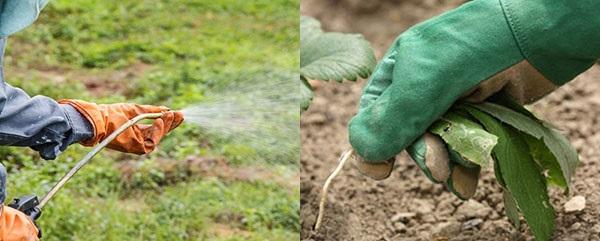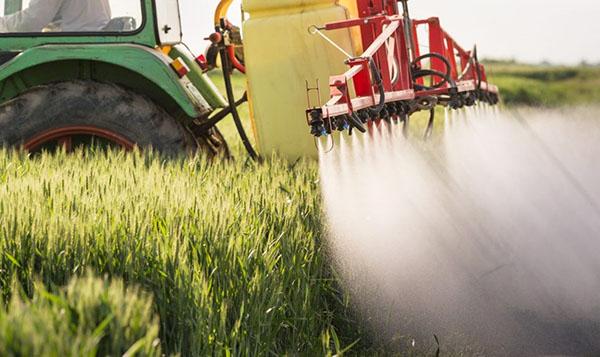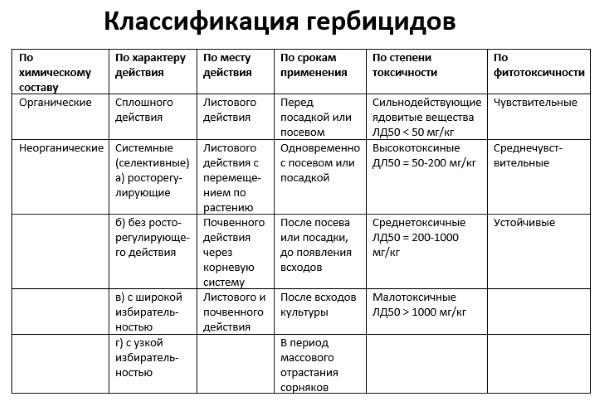Weed herbicides - a great many "helpers" for the gardener
 With the first rays of the hot sun, whole "hordes" of weeds appear in the garden. If you do not use herbicides for weeds, then this vegetation will absorb nutrients from the soil. For example, the field thistle consumes 4 times more nitrogen-containing compounds than cereals. In addition wheatgrass, quinoa, bindweed, knotweed, woodlice and whiteweed grow rapidly, thereby harming the future harvest. Of course, most summer residents try to loosen and care for the beds in time. However, pest plants are so "tenacious" that it is difficult to deal with them. Therefore, chemicals come to the rescue.
With the first rays of the hot sun, whole "hordes" of weeds appear in the garden. If you do not use herbicides for weeds, then this vegetation will absorb nutrients from the soil. For example, the field thistle consumes 4 times more nitrogen-containing compounds than cereals. In addition wheatgrass, quinoa, bindweed, knotweed, woodlice and whiteweed grow rapidly, thereby harming the future harvest. Of course, most summer residents try to loosen and care for the beds in time. However, pest plants are so "tenacious" that it is difficult to deal with them. Therefore, chemicals come to the rescue.
Weed herbicides: many-sided classification
 Manufacturing companies synthesize and produce hundreds of varieties of pesticides that destroy weeds. The preparations have found their use not only in agriculture, but also in deforestation, as well as in the treatment of hay areas with herbicides. In addition, plants grown for medicinal purposes are also recommended to be protected from such "pests". There are many classifications of these chemicals, but it is worth focusing only on the main types of herbicides.
Manufacturing companies synthesize and produce hundreds of varieties of pesticides that destroy weeds. The preparations have found their use not only in agriculture, but also in deforestation, as well as in the treatment of hay areas with herbicides. In addition, plants grown for medicinal purposes are also recommended to be protected from such "pests". There are many classifications of these chemicals, but it is worth focusing only on the main types of herbicides.
They are divided into 5 groups depending on:
- Chemical composition. They are mainly derivatives of amines, triazian, and carboxylic, thiocarbamic and aryloxypropionic acids. Some of them belong to the class of organophosphorus compounds.
- Spectrum of action. Herbicides against weeds there are selective and continuous effects. The first type of chemicals often destroys the very agriculture, and the second - more than 50-300 types at once.
- The method of entry. Contact preparations begin to damage and destroy plant tissue. Systemic ones, on the contrary, penetrate into the vascular system of culture. Then the poisonous substance affects all parts of it.
- Method of application. The working solution is sprayed on the foliage and stems of the weeds. Also, a remedy for perennial weeds is embedded in the soil or distributed over the surface of the earth immediately after sowing.
Some pesticides are applied before, during or after sowing. Others treat the beds on which there are already seedlings (5-15 cm).
 In most cases, herbicides from weeds differ from each other in the mechanism of action on plant tissues. They were divided into 4 groups.
In most cases, herbicides from weeds differ from each other in the mechanism of action on plant tissues. They were divided into 4 groups.
These chemicals can:
- have an impact on the hormonal level;
- interfere with the process of photosynthesis;
- disrupt the synthesis of amino acids;
- inhibit cell division.
 The period of activity of these pesticides lasts from 3 to 18 months. Often poison from weeds of continuous action is of organic or synthetic origin. The most potent drugs are used with a calculation of less than 50 mg per 1 kg, highly toxic - from 50 mg / kg, moderately toxic - up to 200 mg / kg and safe - 1000 mg / kg.
The period of activity of these pesticides lasts from 3 to 18 months. Often poison from weeds of continuous action is of organic or synthetic origin. The most potent drugs are used with a calculation of less than 50 mg per 1 kg, highly toxic - from 50 mg / kg, moderately toxic - up to 200 mg / kg and safe - 1000 mg / kg.
Features of herbicide application - how important it is to see the full picture
 The effectiveness of active substances decreases in dry soil, since they accumulate only in the upper layer of the earth. Moreover, weed control with herbicides will be useless if there is rainfall within 2-4 hours before / after spraying.
The effectiveness of active substances decreases in dry soil, since they accumulate only in the upper layer of the earth. Moreover, weed control with herbicides will be useless if there is rainfall within 2-4 hours before / after spraying.
These drugs play an important role in crop rotation... It is worth knowing that some toxic compounds remain in the soil for more than 1.5 years.Therefore, next year it is not recommended to sow crops that are sensitive to them in this place.
Potatoes are often sprayed with trifluralin complexes, which are dangerous for winter crops. Therefore, after such procedures, wheat or rye cannot be sown in such a field.
The consumption rates of chemicals are calculated taking into account the degree of contamination of the site. The dosage is determined by the amount of weed in 1 m² (from 5 to 100 pieces). In addition, it is important to take into account the aggressiveness of certain types of weeds and the mechanical characteristics of the soil.
Here are some guidelines:
- Vineyards and fruit crops are often treated with herbicides for dicotyledonous and annual cereals. The consumption of the poisonous concentrate is 2-4 l / ha.
- If there are perennial grains on the plantation, then the dosage is increased 2 times.
 However, the regular use of pesticides also has a negative impact. Gradually accumulating in the soil, they inhibit the vital activity of soil microorganisms. Bacteria, algae, fungal spores and flagellates are actively involved in the formation of nutritious humus. The smaller their number, the poorer the soil becomes.
However, the regular use of pesticides also has a negative impact. Gradually accumulating in the soil, they inhibit the vital activity of soil microorganisms. Bacteria, algae, fungal spores and flagellates are actively involved in the formation of nutritious humus. The smaller their number, the poorer the soil becomes.
What herbicide for weeds to buy - features of a difficult choice
 Farmers often have to apply herbicides to vegetables. Therefore, it is necessary that they dissolve well in water, and also break down into useful elements in the soil: oxygen or nitrogen, which strengthen the rhizomes of plants.
Farmers often have to apply herbicides to vegetables. Therefore, it is necessary that they dissolve well in water, and also break down into useful elements in the soil: oxygen or nitrogen, which strengthen the rhizomes of plants.
At the same time, there are some features of the choice of these drugs:
- Completely different concentrates are used for fodder and table beets.
- Root vegetables are treated with chemicals that destroy the root system of weeds.
- Strawberry weed herbicides are applied before the ovaries form (May / June). You can also do this before planting seedlings or after the last harvest.
- Treat other crops with garlic products.
- Cabbage is sprayed only with poison that affects the foliage.
According to some farmers, radish herbicides are not used in agriculture. What are these findings based on? Not known.
 Domestic and foreign manufacturers offer a wide range of universal drugs. A detailed acquaintance with each of them will help you make the right choice.
Domestic and foreign manufacturers offer a wide range of universal drugs. A detailed acquaintance with each of them will help you make the right choice.
"Antiburian" eradicates 300 types of weeds
 The concentrate is used for the destruction of both perennial and annual plants. Its advantage is that during decomposition, chemical elements do not accumulate in the soil. The range of permissible temperatures for exposure to toxic substances is 12-25˚С.
The concentrate is used for the destruction of both perennial and annual plants. Its advantage is that during decomposition, chemical elements do not accumulate in the soil. The range of permissible temperatures for exposure to toxic substances is 12-25˚С.
In the instructions for the use of "Antiburian" one-time treatment is proposed to be carried out at different periods:
- before boarding;
- at the time of active growing season, when the shoots are stretched up to 15 cm;
- after harvest.
It is important to ensure that there is no precipitation for 5 hours after etching. Weed death is observed within 14-21 days. The consumption rate of the concentrated substance is 4-5 l / ha, and the working solution is 150-200 l.
Manufacturers produce packages of 1, 5 or 20 liters. Substance hazard class - 3.
"Shedov" - shadows or weeds disappear at noon
 The country of origin of the Shedov herbicide is France. The active compound in it is cletodim. 1 liter of concentrated essence contains 120 g of this poisonous chemical. To combat annual weeds, it is recommended to spend 400-800 ml of the drug per hectare, and with perennial weeds - 1.4-1.8 l / ha.
The country of origin of the Shedov herbicide is France. The active compound in it is cletodim. 1 liter of concentrated essence contains 120 g of this poisonous chemical. To combat annual weeds, it is recommended to spend 400-800 ml of the drug per hectare, and with perennial weeds - 1.4-1.8 l / ha.
The crops are sprayed at a height of annual weeds of 5 cm, and perennials - 15-20 cm.
"Miura" - Japanese version
 It kills most types of weeds, including wheatgrass, bristles, wild oats and chaff. At the same time, the herbicide "Miura" does not damage agricultural crops. The multiplicity of treatments per season is one, since the beds remain protected from weeds for 45 days.Spraying of annual vegetative plants is carried out in the phase of 2-4 leaves, and of perennial ones - 15-20 cm. The working solution of the Miura herbicide is prepared with the calculation of 4-8 ml per 5 liters of water. This amount of liquid is enough to process 1 weave.
It kills most types of weeds, including wheatgrass, bristles, wild oats and chaff. At the same time, the herbicide "Miura" does not damage agricultural crops. The multiplicity of treatments per season is one, since the beds remain protected from weeds for 45 days.Spraying of annual vegetative plants is carried out in the phase of 2-4 leaves, and of perennial ones - 15-20 cm. The working solution of the Miura herbicide is prepared with the calculation of 4-8 ml per 5 liters of water. This amount of liquid is enough to process 1 weave.
Experts recommend using the chemical for planting potatoes, cabbage (all types) and onions.
"Webb" - always online
 The preparation contains tribenuron-methyl, as well as ammonium sulfate. These compounds have a depressing effect on dicotyledonous plants, which most often affect cereal crops. The application rate of the Webb herbicide is 15-25 g / ha, and the water essence is 200-300 l / ha. The result of the action will become apparent in 5-8 days, and the landing will be protected for 1 month.
The preparation contains tribenuron-methyl, as well as ammonium sulfate. These compounds have a depressing effect on dicotyledonous plants, which most often affect cereal crops. The application rate of the Webb herbicide is 15-25 g / ha, and the water essence is 200-300 l / ha. The result of the action will become apparent in 5-8 days, and the landing will be protected for 1 month.
This chemical is low-toxic and belongs to the III hazard class. For this reason, it has no effect on crop rotation in the crop rotation.
"Pharaoh" - Egyptian variations

Often the concentrated emulsion is used as an insecticide to control insects:
- aphids;
- ticks;
- scoops;
- fireflies;
- thrips;
- scabbards;
- locusts.
To treat 1 hectare of the area planted with soybeans and corn, up to 200-400 liters of solution are consumed. This volume of liquid will require 1-1.5 liters of concentrate. In addition, a special drug "Pharaoh" for weeds is sold in pharmacies. 1 liter of the product contains up to 450 g of a poisonous mixture - glyfost.
You also need to know how to neutralize the herbicide in the soil. Experts recommend: sow green manure, add organic matter, and also use immunostimulants or antidotes — drugs that reduce the toxicity of pesticides.
"Nanomet" - ultra-precise
This systemic drug of selective action is used only for weeds that grow in crops of barley (spring), oats and wheat of different varieties. The herbicide "Nanomet" is on sale in the form of a powder mixture. For 1 ha of area, 200 or 300 liters of solution are used. About 0.008-0.01 kg / ha are added to this volume of water. 1 kg of products contains more than 600 g of the active substance - metsulfuron-methyl.
When using it, you must comply with the restrictions associated with crop rotation.
"Zernodar" - Ukrainian standard
 The main purpose of the herbicide "Zernodar" is grain crops. The preparative form of the substance is granules that are dissolved in water. It contains tribenuron-methyl at the rate of 750 g per 1 kg of the mixture.
The main purpose of the herbicide "Zernodar" is grain crops. The preparative form of the substance is granules that are dissolved in water. It contains tribenuron-methyl at the rate of 750 g per 1 kg of the mixture.
It is used as a post-emergence agent for the destruction of:
- sow thistle;
- chamomile;
- ambrosia;
- rapeseed;
- sunflower carrion;
- stars.
Crops of barley, rye and wheat of spring / winter varieties are treated with an aqueous emulsion at a rate of 150-250 l / ha. To do this, take 15-25 mg of the concentrate and dilute it in 100 liters of liquid. The first signs of the drug's action are observed on the 5th or 7th day, and the complete death of weeds occurs on the 20-25th day.
The active ingredient loses its properties in dry or cool weather. Optimum temperature for its activity: 10-20˚С.
"Shantus" - no chance of survival
 The active chemical compound of the Shantus herbicide is rimsulfuron, which contains 250 g in 1 liter of the chemical. To prepare an aqueous emulsion, 2-5 ml of concentrate is diluted in 200-300 liters of water. The minimum value is used for annual weeds, and the maximum for perennial ones.
The active chemical compound of the Shantus herbicide is rimsulfuron, which contains 250 g in 1 liter of the chemical. To prepare an aqueous emulsion, 2-5 ml of concentrate is diluted in 200-300 liters of water. The minimum value is used for annual weeds, and the maximum for perennial ones.
It is used only for corn and potatoes. The validity period is 60 days.
"Matador" - Spanish version
 Matador is rarely used as a herbicide.
Matador is rarely used as a herbicide.
This insecticide is more relevant for the control of soil pests:
- Colorado potato beetle;
- a gnawing owl and its caterpillars;
- ground beetle;
- aphids;
- flea beetles;
- wireworm.
Potato tubers and cereal crops are processed before planting. For 1 ton of seed, 0.9-1 and 0.75-1.5 liters of the drug are consumed (respectively). For such dosages, 10-15 liters of water are taken.
Some gardeners claim that weeds grow in 2 times less on the treated areas.However, these are only their personal observations.
This short review showed that weed control herbicides are a great way out of a tricky situation. Using such preparations, the gardener will be able to grow a truly rich harvest.